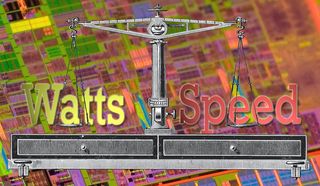Clarkdale Efficiency: The Perfect Clock Rate For Intel's Core i5-661

What’s The Perfect Clock Speed For Intel’s New Dual-Cores?
Almost every processor can be easily overclocked on a decent motherboard. However, at some point, you'll have to boost the voltage to reach faster clock speeds, causing the processor to consume a lot more power.
There is a point at which every processor delivers its best performance per watt, though, and it happens way before you hit the chip's maximum overclock. Now it's time to determine this perfect clock speed for Intel's new Clarkdale dual-core architecture, which we know as the Intel Core i3 and Core i5.

We already executed this type of analysis on several other systems and discovered some interesting facts:
- In the case of a Phenom II X4 quad-core (Deneb) on the Socket AM3 interface, the best performance at acceptable power consumption is reached at roughly 3.6 GHz.
Read the article Optimizing Your Phenom II Overclock For Efficiency
- For a Core 2 Duo E8000-series (Wolfdale), based on the LGA 775 interface, the most efficient overclock speed is about 3.8 GHz.
Read the article Overclocking Core 2 Duo: Power Versus Performance
- The Core i7-900-series quad-core (Bloomfield) running on an LGA 1366 interface delivers best performance per watt at 3.66 GHz.
Read the article Overclocking Core i7: Power Versus Performance
- Finally, we also analyzed efficiency on the Core i5-700-series quad-core (Lynnfield) for LGA 1156 and found efficiency to be best at 3.2 GHz, with the Turbo Boost feature enabled and pushing performance up to 3.84 GHz.
Read the article Efficiency Explored: What’s The Perfect Clock Rate For Your Core i5?
Stay On the Cutting Edge: Get the Tom's Hardware Newsletter
Get Tom's Hardware's best news and in-depth reviews, straight to your inbox.
While the 45nm Core 2 Duo reached top performance per watt at about 3.8 GHz, we expected higher clock speeds on the Core i5 dual-cores. Although the graphics unit is integrated with the processor, the new chips have a substantial advantage, thanks to Intel's new 32nm process.
Many online sites have reported getting Core i5 dual-cores to 4.2 or even 4.5 GHz on air cooling with comparatively little effort. You'll even find reports of hitting 6 to 7 GHz using liquid nitrogen, which is proof of the architecture having lots of overclocking headroom. Perhaps we'll even be able to reach 5 GHz on air cooling once Intel releases modified processor steppings in the next few months.
We grabbed our Core i5-661 dual-core sample (3.33 GHz nominal clock speed, 3.60 GHz with Turbo Boost operating on a single core, 900 MHz graphics clock speed) and overclocked it by raising the base clock (BCLK). At this point, it's important to watch the graphics core’s clock speed, as it also derives from the system’s base clock. Our overclocking focused on increasing the base clock in an effort to boost the processor’s nominal speed, leaving Turbo Boost and all power saving features, such as C-steps and SpeedStep, enabled.
Current page: What’s The Perfect Clock Speed For Intel’s New Dual-Cores?
Next Page Clarkdale And Turbo Boost